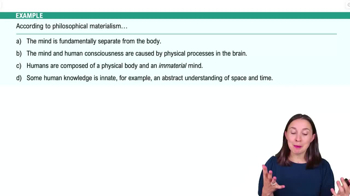Table of contents
- 1. Introduction to Psychology1h 43m
- 2. Psychology Research2h 20m
- 3. Biological Psychology2h 41m
- 4. Sensation and Perception28m
- 5. Consciousness and Sleep32m
- 6. Learning41m
- 7. Memory34m
- 8. Cognition37m
- 9. Emotion and Motivation35m
- 10. Developmental Psychology33m
- 11. Personality48m
- 12. Social Psychology41m
- 13. Stress and Health41m
- 14. Psychological Disorders44m
- 15. Treatment47m
1. Introduction to Psychology
What is Psychology?
Struggling with Psychology?
Join thousands of students who trust us to help them ace their exams!Watch the first videoMultiple Choice
Talking, facial expressions, and movements are elements of
A
behavior.
B
mental processes.
C
biopsychology.
D
humanism.
 Verified step by step guidance
Verified step by step guidance1
Identify the key elements mentioned in the problem: talking, facial expressions, and movements.
Understand that these elements are observable actions or responses.
Recall the definition of 'behavior' in psychology, which refers to any observable action made by a living person or animal.
Differentiate between 'behavior' and 'mental processes,' where mental processes are internal and not directly observable.
Conclude that talking, facial expressions, and movements are best categorized under 'behavior' as they are observable actions.

 1:53m
1:53mWatch next
Master Intro to Psychology with a bite sized video explanation from Hannah Gordils
Start learningRelated Videos
Related Practice
































